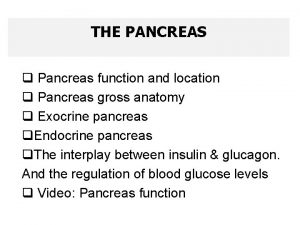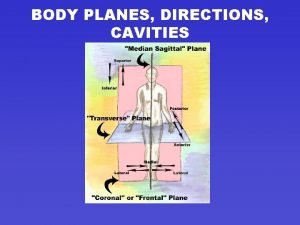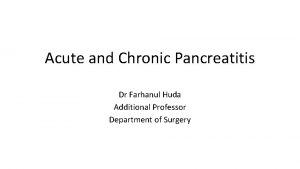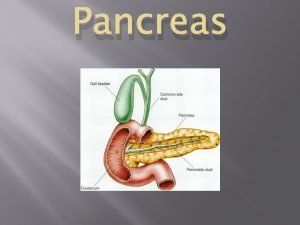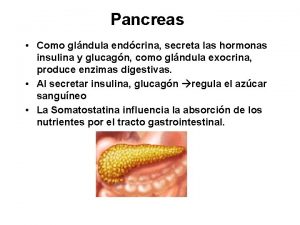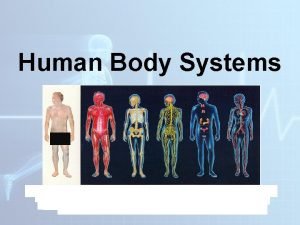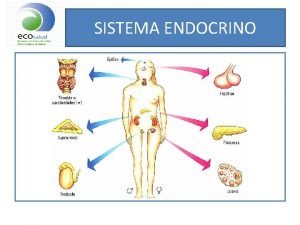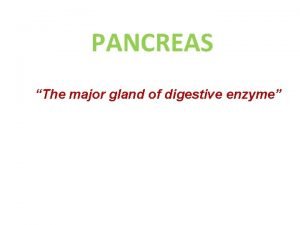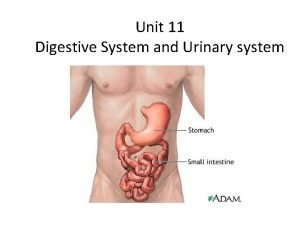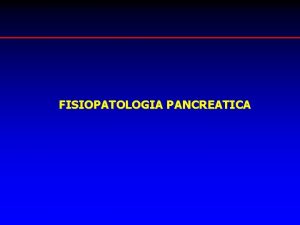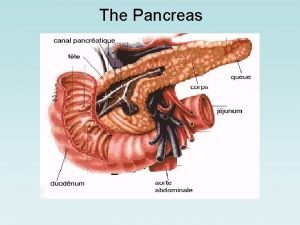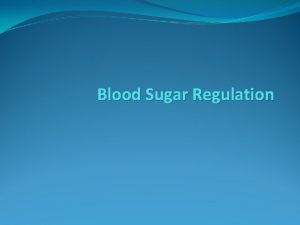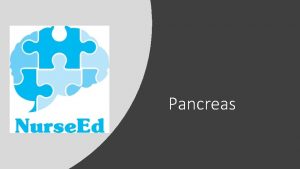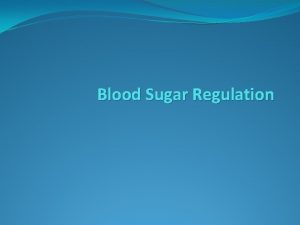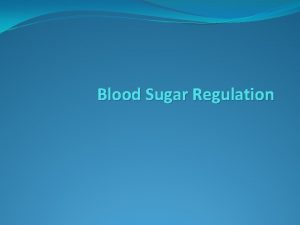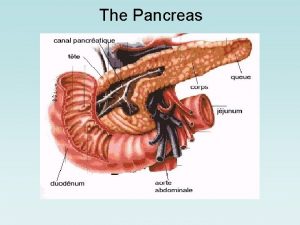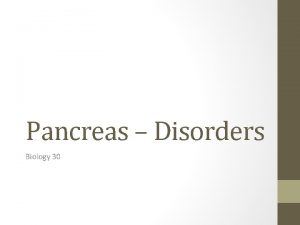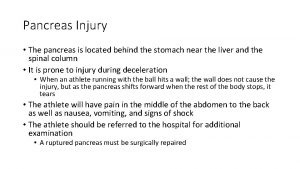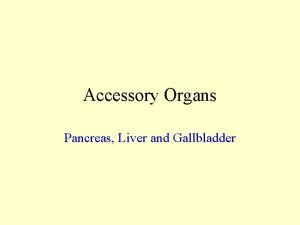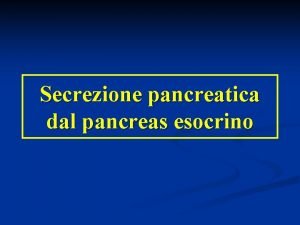The Pancreas The Pancreas Located near the small



















- Slides: 19

The Pancreas

The Pancreas • Located near the small intestine • It produces 2 non-steroid hormones: 1. Glucagon 2. Insulin • Glucagon and Insulin are produced in a regions of cells of the pancreas called the Islets of Langerhans

Diabetes Animation • http: //www. youtube. com/watch? v=Naz. ZCu 1 lw. OE&feature=rellist&playnext=1&list =PL 49290 BC 728 D 88 B 75&safety_mode=true&persist_safety_mode=1&safe=active


Explain how insulin and glucagon are antagonistic hormones? • Antagonist hormones – hormones that do opposite things • Insulin is produced in response to HIGH levels of glucose in the blood • Glucagon is produced in response to LOW levels of glucose in the blood

Glucose homeostasis Insulin Beta cells of pancreas stimulated to release insulin into the blood High blood glucose level STIMULUS: Rising blood glucose level (e. g. , after eating a carbohydrate-rich meal) Body cells take up more glucose Liver takes up glucose and stores it as glycogen Homeostasis: Normal blood glucose level (about 90 mg/100 m. L) Blood glucose level rises to set point; stimulus for glucagon release diminishes Figure 26. 8 Blood glucose level declines to a set point; stimulus for insulin release diminishes Liver breaks down glycogen and releases glucose to the blood STIMULUS: Declining blood glucose level (e. g. , after skipping a meal) Alpha cells of pancreas stimulated to release glucagon into the blood Glucagon

What effect does insulin have on the body? 1. It increases the amount of glucose that gets stored in the liver 2. It causes muscle to store glucose 3. Glucose is used to make fat Insulin STORES glucose in the body

What effect does glucagon have on the body? 1. It increases the levels of glucose in the blood 2. It causes liver cells and muscle cells to release glucose 3. Fat tissue releases glucose Glucagon RELEASES glucose from the body

• Amelia's Story. . . a baby's journey with Type 1 (juvenile) Diabetes http: //www. youtube. com/watch? v=s. Eb. CW 3 b BNG 8&feature=related

What happens when the body does not make enough insulin? 1. Type 1 Diabetes (also called Diabetes Mellitus) 2. Type 2 Diabetes

What is Type 1 Diabetes? • An autoimmune disease, where the body’s own immune system attacks the insulinproducing cells in the pancreas • The body stops being able to make insulin

What is Type 2 Diabetes? • Considered an adult disease, the body can make insulin, however the amount may not be enough or the body is unable to recognize it • Poor diet & exercise can lead to this

Why is Diabetes so dangerous? • Sugar level in blood (& urine) is too high • Glucose restricted from entering the cells, causing the body to lose its main source of fuel even though the blood contains large amounts of glucose.

What are the symptoms of diabetes? • • • Fatigue weight loss constant thirst excessive urination irritability

How is diabetes treated? • daily injections of insulin • injections of short acting before meals and injection of long lasting at bedtime • diabetics should regularly check their blood sugar with a glucometer http: //www. iflscience. com/health-andmedicine/trial-announced-diabetes-drugfollowing-success-mice

• Fredrick Banting (surgeon) and Charles Best (chemist) discovered a way to treat Diabetes – disabled the pancreas in dogs to induce diabetes – isolated an insulin extract which was given to patients

Diabetes in NL According to Canadian Diabetes Association (2010) • 47000 people reported having Type 1 or Type 2 Diabetes (9. 3% of the population) • Cost of Diabetes to the province $254 million • Hospitalization (16%) • Mortality/disability (84%) • These statistics are expected to rise in the next 10 years. Why?

Provincial Initiatives (Since 2005) • Wellness Plan • Go Healthy Initiatives • Coverage for insulin pumps/supplies for individuals up to age 25 Type II diabetes on the rise among children http: //video. msnbc. msn. com/nightly-news/47238850#47238850

Diabetes Lab • http: //www. youtube. com/watch? v=Lt 7 RCIfud YQ&safe=active
 Location of the pancrease
Location of the pancrease Body parts located near the sacral region
Body parts located near the sacral region Seattle seahawks tackling drills
Seattle seahawks tackling drills Pancreas divisum surgery
Pancreas divisum surgery Pancreas funzione
Pancreas funzione Dbt mody
Dbt mody Production bile
Production bile Regulacion hormonal
Regulacion hormonal Pineal and pancreas glands
Pineal and pancreas glands Tmpi páncreas pronóstico
Tmpi páncreas pronóstico Pancreas anatomia e fisiologia
Pancreas anatomia e fisiologia Function of pancreas
Function of pancreas Sistema exocrino dibujo
Sistema exocrino dibujo Where is kidney pain felt diagram
Where is kidney pain felt diagram Pancreas
Pancreas Rana sistema digestivo
Rana sistema digestivo Spancreas
Spancreas Conducto coledoco y pancreatico
Conducto coledoco y pancreatico Gastric glands
Gastric glands Somatostatina funzione
Somatostatina funzione
